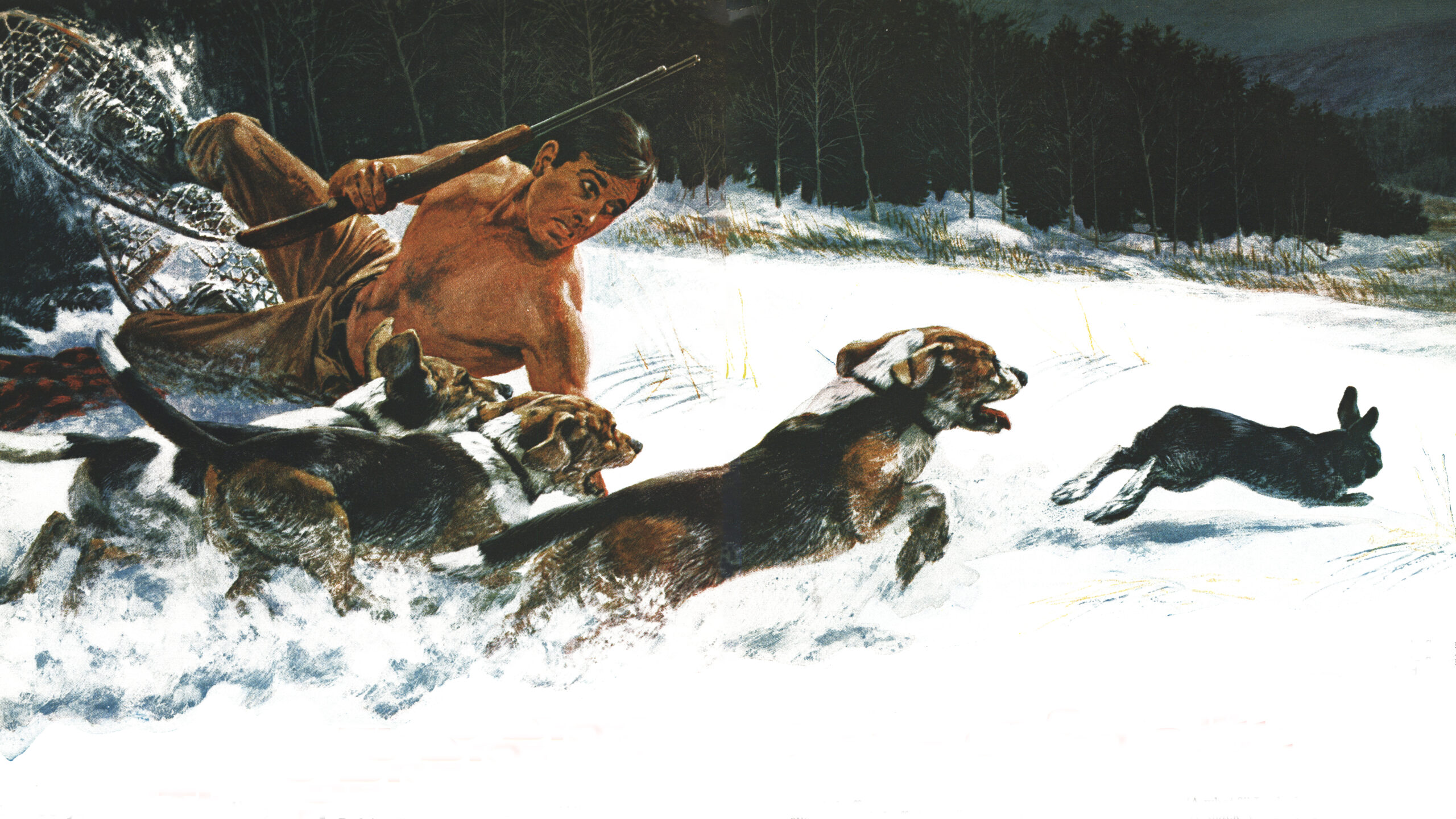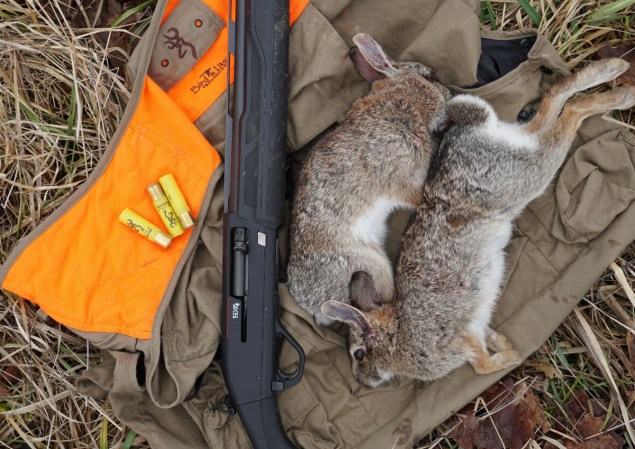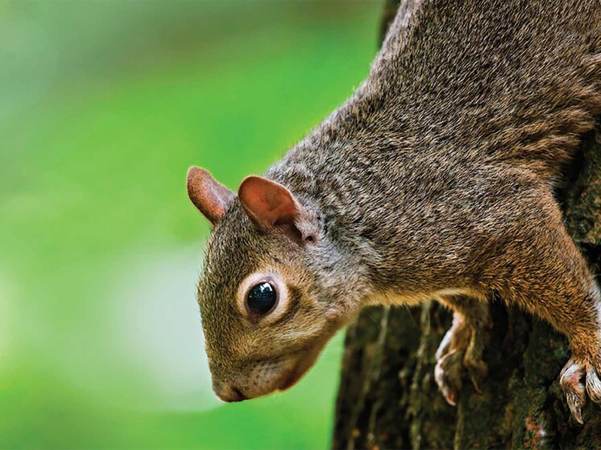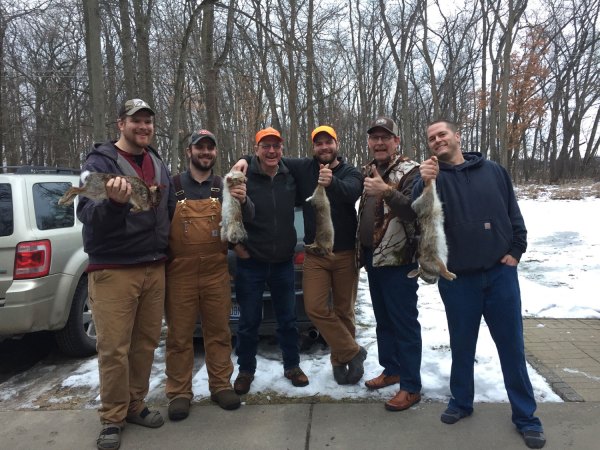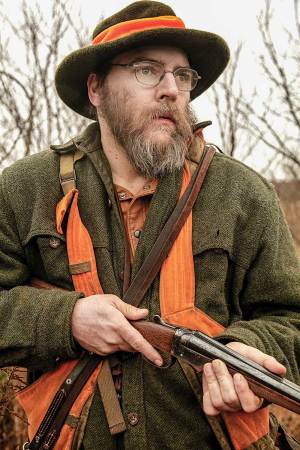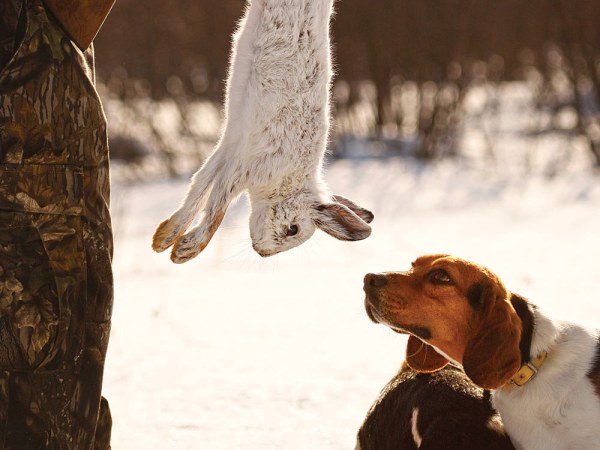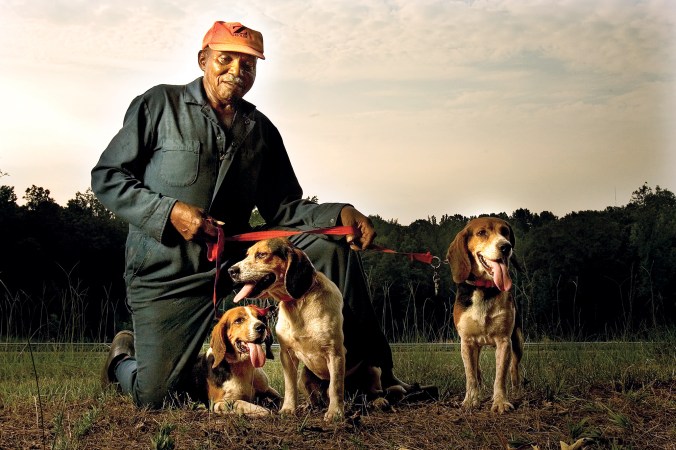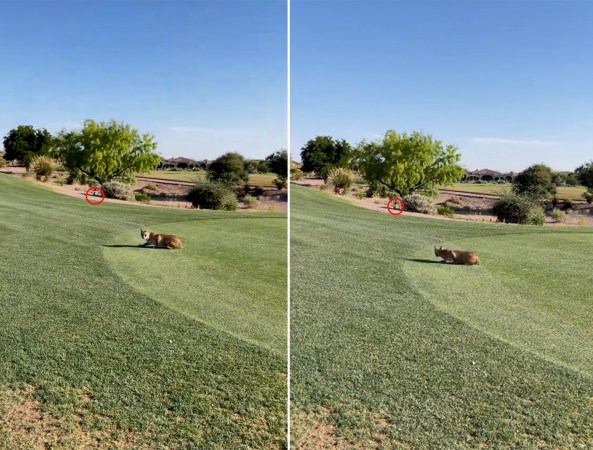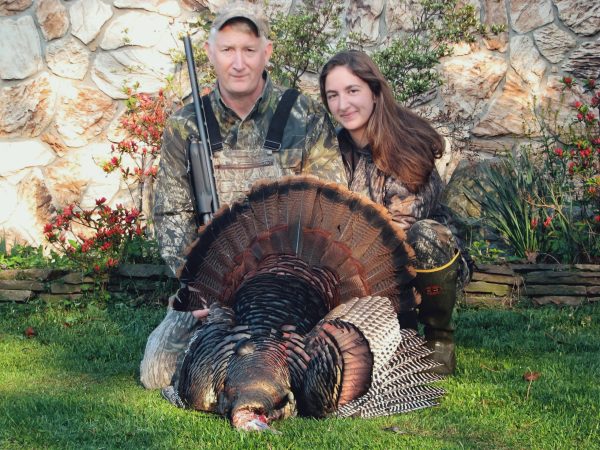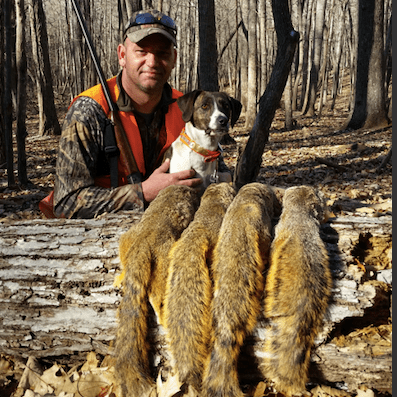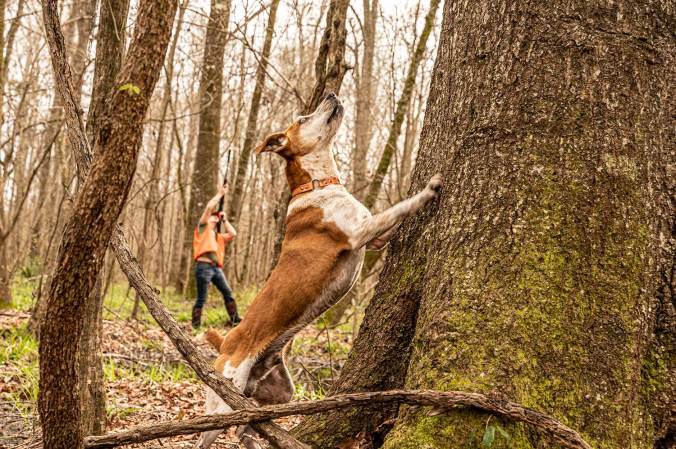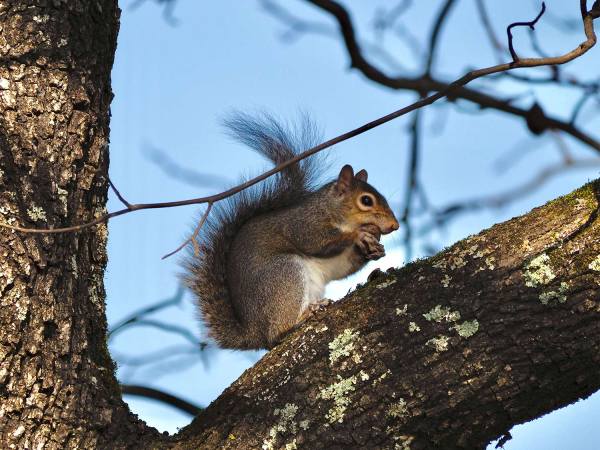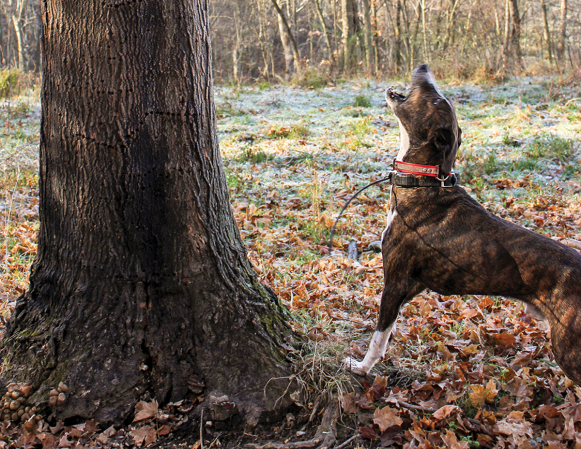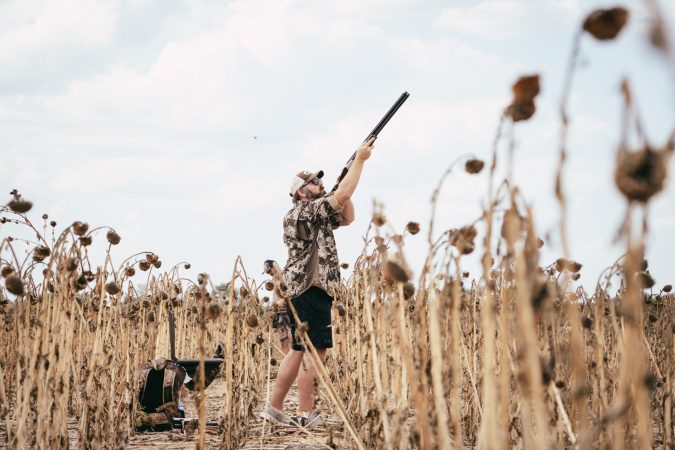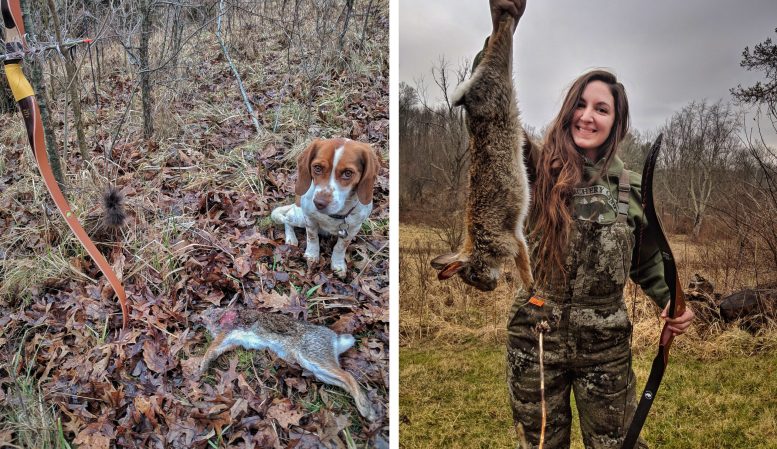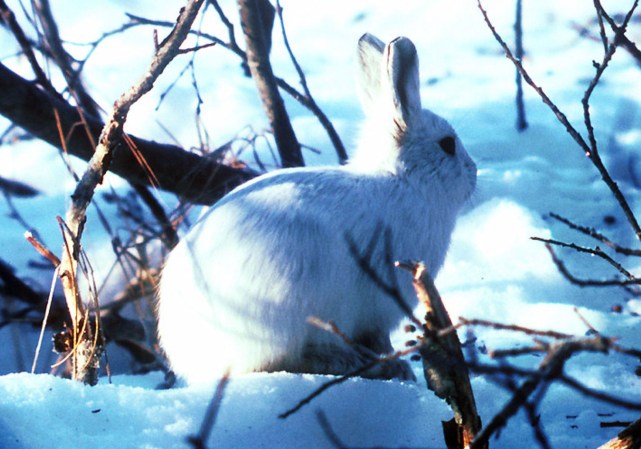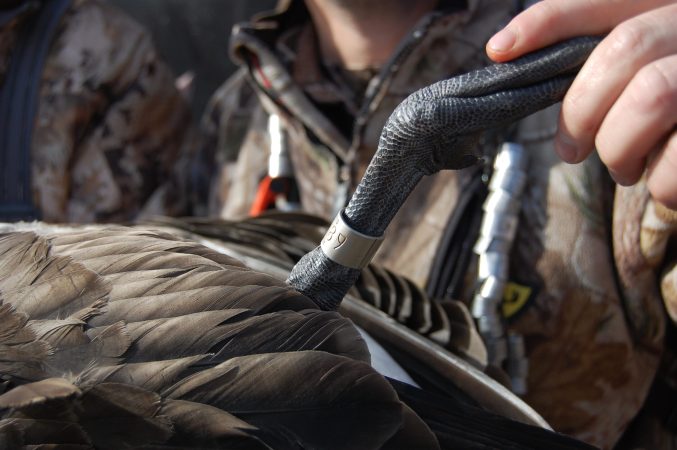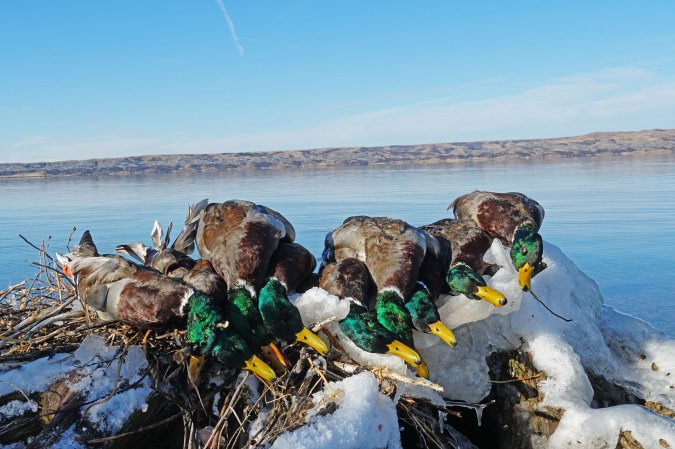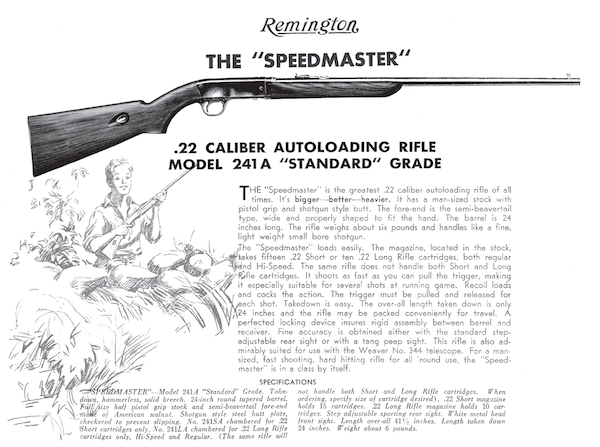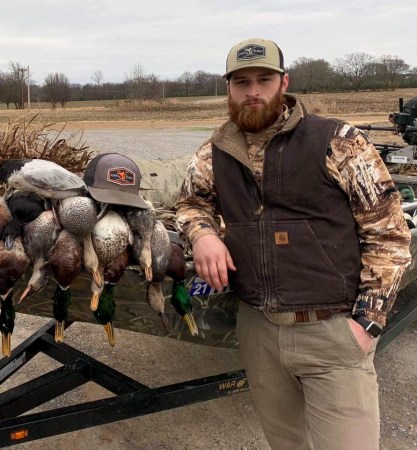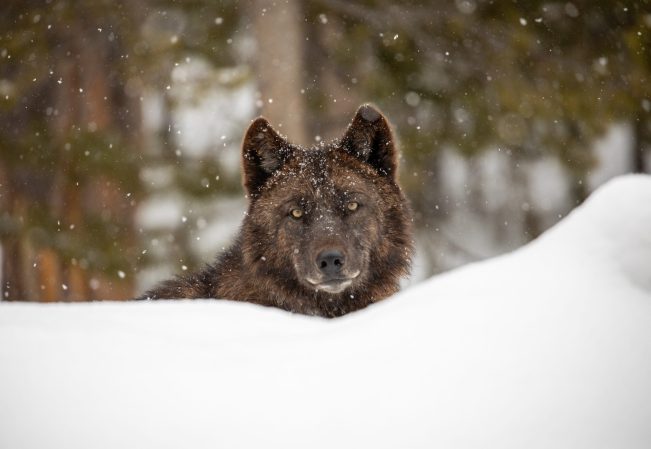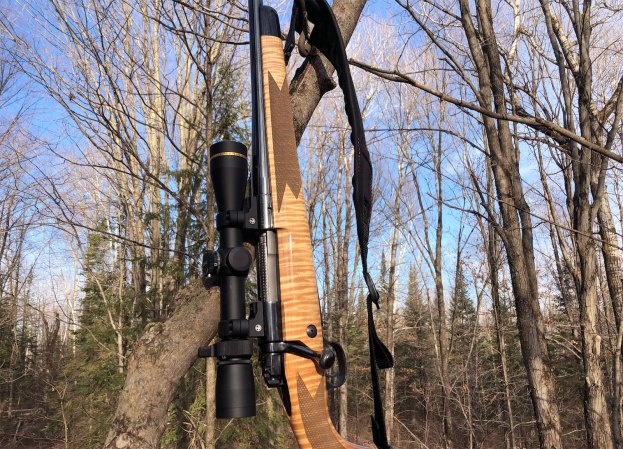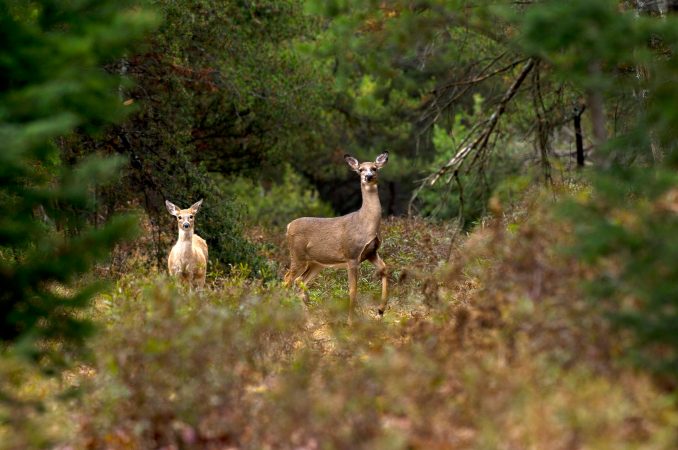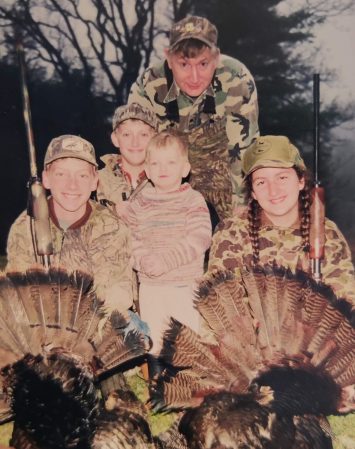This article, originally titled “The Black Hare of Halcott,” first ran in the October 1968 issue.
“IF THE HOUNDS don’t bring that rabbit around soon, Dad, it will be too dark to shoot,” said my nine-year-old son Eddie as he stomped his feet to keep warm. “It must be an old male to run circles that big,” I answered. “If this weren’t cottontail country, I’d swear they had a snowshoe going. Seems to me they’ve covered half of Steuben County in the last half-hour.”
Another 10 minutes passed before the bawling beagles started back our way. Then a slight movement caught my eye. To our left, where an old stone wall edged a spruce plantation, a patch of gray appeared. Nimbly, a gray fox jumped up onto the wall and peered intently toward the oncoming hounds.
“Don’t move,” I whispered as I eased my .22 autoloader to my shoulder.
When the rifle cracked, the fox leaped straight up, tumbled off the wall, and plunged blindly into the thick evergreens.
“Wow, Dad, what made him jump so?” Ed asked excitedly.
“Heart shot, I hope,” I replied. “If that’s what Briar and Buckshot were running, it’s no wonder they’ve been making such big circles. Go see if I got him, Son. If I did, half the five-dollar bounty is yours toward your new snowshoes.”
A half-hour later, fox and hounds in tow, we were greeted by my wife Theresa at the door of our frame home outside Bath in the Southern Tier of New York State.
“Your dad wants you to call him right away,” she told me. “He’s all excited about something. It didn’t make sense. Who ever heard of a black white rabbit.”
“A what?” I asked.
“A black white rabbit!” she repeated. “Oh, what’s the difference brown, white, black. You and the boys are late for supper every time you hunt them. Now get those smelly old hounds out of my kitchen.”
I winked at Ed as he coaxed the two beagles out the back door, and then I bestirred myself to get the long-distance operator. In a minute my call was placed to Art Flick Sr., who has been a full-time guide in the Catskill Mountains of eastern New York for the better part of his life.
“What’s up, Dad?” I asked.
“Son, I know I’ve got no right to suggest that we change our plans for our annual Christmas hare hunt next week,” he told me, “but you’ll never believe what I saw up on Halcott Mountain today. A black snowshoe rabbit. So help me, old Tiny brought him around three different times, but I never could get a whack at him. He looked big as a house cat and black as the inside of a cow. I’d sure like to have you boys come down here so we could have a go at him.”
“You know I’d come in a minute, Dad,” I replied, “but it’s Bill’s turn to host our annual hunt, and everyone’s plans are made. Black rabbit or not, I’m afraid we’re committed to hunt the Adirondacks this year.”
Christmas hare hunts have been a tradition in our family ever since Bill, my oldest brother, got his first hunting license back in 1943. He’s a fisheries-research associate and lives on a 27,000-acre wildlife paradise in the Adirondack Mountains where he does research for Cornell University. We rotate our annual hare hunts between his place, the family homestead in the Catskills, and my place in the Southern Tier.
Before meeting at Bill’s for our ’58 Christmas hunt, I had occasion to check in at conservation headquarters in Albany, N.Y. While there, I did a little research of my own on black varying hares. I also looked up Joe Dell, chief wildlife biologist for the game-research section of the Bureau of Game. After leading me through a happy haze of biological jive, he informed me that a black hare is really a melano.
“He zigged when he should have zagged when he came to color,” Joe told me, chuckling. “Instead of being brown in the summer and white in the winter, he’s black. Melanos, like albinos, are extremely rare. Anyone who’s lucky enough to bag one has a real trophy. According to our records, the last one killed in the Catskills was taken back in 1925 on Halcott Mountain.”
“Halcott Mountain!” I exclaimed. “Why, that’s where the hare I’m talking about was seen.”
I could hardly wait to see Dad and Bill to tell them what I’d learned. From that moment on, the Halcott Mountain oddity dominated our conversation.
“If I thought he could survive till next season, I’d leave him alone,” Dad said over a glass of Bill’s homemade chokecherry wine on Christmas Eve. “Only thing in his favor is being up on Halcott Mountain. We’re the only damn fools who’ll hoof it clear up there for the few hares that live in that swamp on top. But there’s always the chance that a predator will nail him. He’s so darned conspicuous on the snow, I think I’d better try for him when I get back home,” he reasoned.
Following our hunt at Bill’s, I returned to my work as a forester at Bath with the N.Y. State Conservation Department. I also do some part-time guiding there. It was too much to hope that the melano would be around the next year for our hunt at Dad’s place in the Catskills. My six-year-old son Johnny helped me to put thoughts of the unusual hare out of my mind.
“Maybe Grampy’s eyes aren’t so good any more,” he said, child fashion. “Prob- ably he really saw a dirty white rabbit.”
But Grampy was out to prove different. Before the season closed on February 29, he made two more trips to the top of the 3,500-foot mountain to try for the black white rabbit.
“The capers that rascal pulled on those poor hounds were enough to give a dog heartburn,” he wrote after his last unsuccessful Halcott Mountain hunt. “I got to see him one more time, but he made a monkey of me,” Dad lamented. “My lead was just right, but the instant I fired, he stopped. I must have missed him by four feet.”
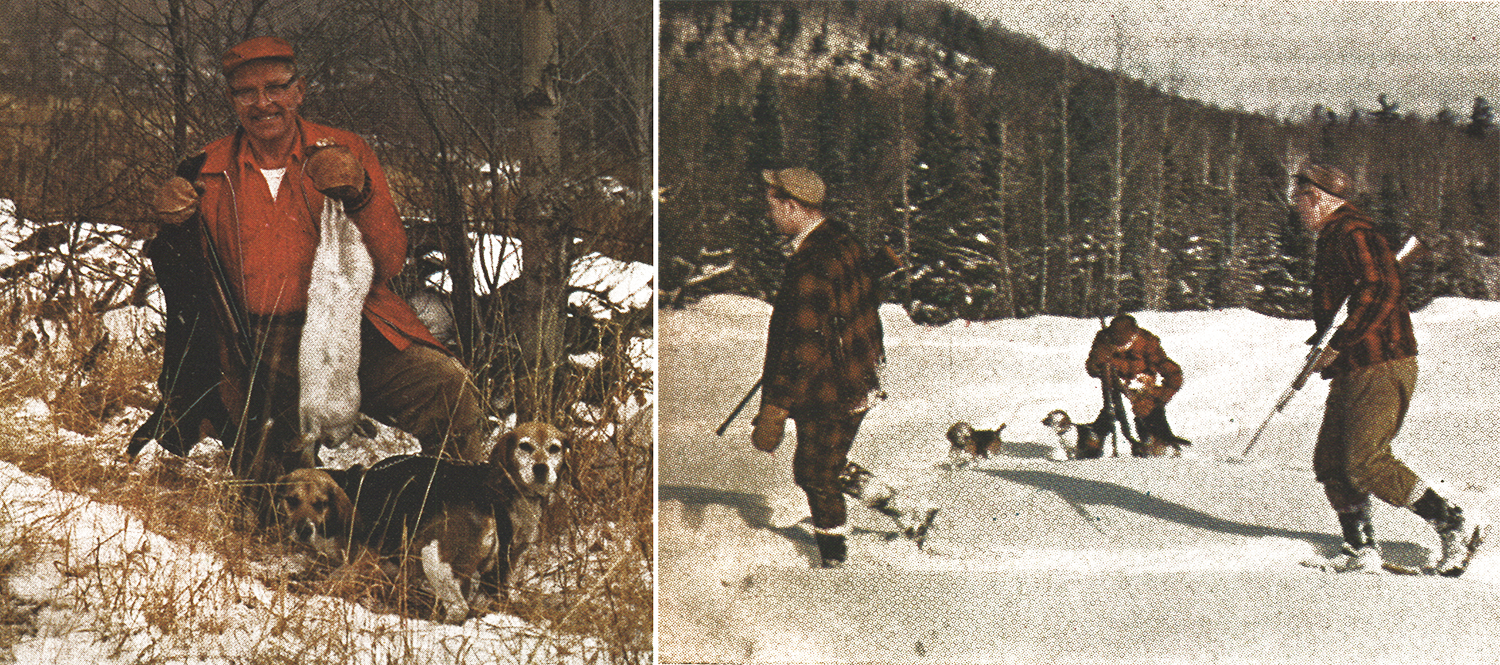
The hunting for varying hares in the Catskill Mountains differs a little from hunting in the Adirondacks, New England, or the Lake States. The critters aren’t abundant, and most of them live on the tops of mountains. You’ll find Catskill snowshoes where stunted hardwoods grade into a mixture of man-high conifers some 2,500 to 3,000 feet above the valley floor.
On occasion a population spillover sends scattered hares down among the cottontails in the reforested areas along the lower slopes. When the visitor is chased by a flop-eared hound, however, there’s no guarantee he’ll circle. More often than not, the snowshoe heads for the top of the nearest mountain and stays there. Therefore, most serious hare hunters head for the high country.
That move entails a risk. Weather and snow conditions may be fine down in the valley, but put a couple thousand feet of elevation behind you, and you’re in a different world. Snow conditions, temperature, and wind may all be different. Sometimes the change is so drastic that hunting is impossible. Nevertheless we still concentrate on the snowshoe rather than his cousin, the cottontail. The big hare may not equal the cottontail as a culinary delight, but his habit of not holing up endears him to the true houndsman who revels in the chase. And we Flicks love the chase!
During the fall of ’59, Dad was booked full with hunters of grouse, woodcock, and deer, so he had no time to see if the melano had made it through the summer, though in November he did receive an encouraging report from a local deer hunter. While tracking a wounded buck through the swamp on top of Halcott Mountain, he had jumped a coal-black rabbit. Dad was elated. The hare was still alive.
THE 1959 Christmas holidays blew in on the heels of a sharp cold wave that threatened to finish our melano hunt before it started. By Christmas morning, however, the temperatures had moderated to a modest 18° above zero. To brighten the picture, a fast-moving storm had put an inch of new snow down the length of the valley on Christmas Eve. Dad allowed that conditions should be good on top of Halcott, provided the wind didn’t come up strongly.
“Shall we use the shotguns or stick to the .22’s?” Bill asked.
Now my dad is a purist in the strictest sense of the word.
“The melano gets no preferential treatment,” he decreed. “Either we get him fair and square with rifles or we go without.”
Which .22 rifle is best for this type of hunting is a subject that often keeps the hot-stove league bubbling for hours. Bill prefers the little lightweight Browning autoloader, Dad favors the autoloading Remington Model 552, and I stick to the Savage Model 6 autoloader I bought as a youngster with furs from my trapline.
Among us we have seven beagles. On our Christmas hare hunts, we each choose one hound we feel will be the best under that day’s running conditions. Dad’s old Tiny dog, Bill’s 15-inch Star, and my four-year-old Briar won nods to go after the melano. The four other hounds were left behind to serenade our wives.
AS SOON AS the youngsters had opened presents Christmas morning, the hunters headed for Halcott Mountain. We drove up the Beech Ridge road to the base of the mountain and parked the car.
The minute we let the dogs out, they jumped a cottontail and were off. Dad was furious.
“I knew we should have leashed the mutts till we got through that brushlot,” he grumbled.
It took about 15 minutes before the dogs wheeled the plump cottontail by me. Luck was with us, and I dispatched the rabbit with a single hollowpoint on the first circle. After a quick gutting job, I hung him in a tree fork to pick up on our way back. Then we started off on the exhausting climb up Halcott Mountain.
We hadn’t gone 200 yards up the timbered slope before we started peeling off our coats. By the end of the first half-hour we were down to our undershirts, and we were still almost sweating as we plodded through the deepening snow. Halfway up we had to stop and put on our snowshoes. From there on, we took turns breaking trail, and the dogs tailed along patiently behind.
About the time we hit the last bench of ledges down from the top of the mountain, the dogs led on out. Minutes later, when we stopped for a breather, we heard old Tiny sounding off high above us.
“It may be the melano. Let’s get moving,” Dad said urgently.
We foolishly charged to the top of the mountain. The sudden exertion started the perspiration flowing freely from all of us.
“It’s a wonder the dogs are getting enough scent out of that powdered snow to run,” Bill muttered. “It must be close to zero up here.”
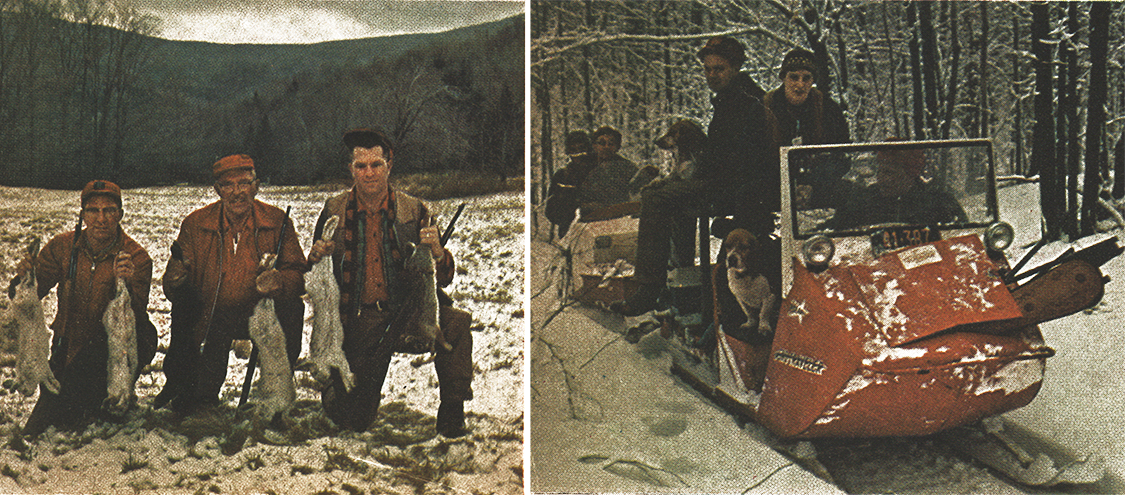
We made certain we knew where each man was to stand and then listened to the bawling hounds. By the time the hare had circled the second time, I was shivering because of my sweat-soaked underclothes. Star had joined in with Tiny, and they were really turning it on. My Briar dog, being reluctant to run with other dogs on a rabbit that he didn’t start, was off by himself trying to straighten out a cold track.
The two other dogs were out of hearing when I spotted a movement in a tangle of evergreens to my left. Thinking it was Briar, I called out, “Go get one started, you old fool.” To my chagrin, a snowshoe bounded out and then disappeared like a spook into the safety of the swamp.
“Must have been a stray,” I thought. I started to call Briar to put him on the track when I heard the other dogs coming back. Suddenly they quit. It took only a minute for them to make up the loss, and then they headed right for Bill.
I can always tell Bill’s shooting from Dad’s because he shoots his autoloader in short bursts, a habit he traces back to his army days. Dad grinds his shots out slowly and methodically. I do one or the other, depending on my degree of excitement.
In this case, the gunfire came in short bursts.
“Got him,” Bill yelled. “It’s a white one.”
“Good boy,” Dad called from the far edge of the swamp. “Now let’s head east to the far point. That’s where I jumped that black rascal the last time I was up here.”
“Hold it a minute,” I shouted. “I’ve got to get this wet undershirt off before I shiver right out of my snowshoe harness.”
I LEANED my rifle against a small balsam and started to strip. As I peeled off the sweat-soaked undershirt, Briar put his nose right on a hare not 50 yards away and sight-ran it right toward me. The other dogs picked up the cry, and all three burst from the swamp not five jumps behind the hare. It was the melano!
Dad, sportsman that he is, frowns on shooting hares before they make a full circle, but in this case I was willing to risk his wrath.
I lunged for the rifle, but I put one snowshoe on top of the other. As I shifted my weight to swing the rifle to my shoulder, I lost my balance and the tangled snowshoes pitched me headlong into the snow.
“It’s the melano,” I cried, spitting out the white powdery stuff. “He damn near ran over me.”
The chase was on. Clumsily, I struggled to my feet. The melano made a tight circle and headed right back toward where I stood, half naked, with my rifle full of snow.
The whole entourage passed within easy shooting distance of me, but I was helpless. Numb from the cold, I fumbled into my wool shirt and bent to the task of cleaning my rifle. Laboriously, I unloaded, freed up the action, and blew the snow out of the barrel. Meantime the hounds and the hare passed out of hearing. They circled four times before Bill finally cut loose with a seven-shot burst. There was a pause and then five more rapid shots.
His muffled yell drifted faintly through the snow-laden evergreens. Had he connected? The dogs answered my question. They kept coming. Bill had missed, and the hounds were heading my way.
I saw the black hare silhouetted against the backdrop of white snow as he darted between two balsams. Then he stopped.
Slowly, carefully, I raised my rifle—Dad’s long-standing advice to move slowly was paying off. The melano never moved. He was backed up against a small sapling and listened intently to the approaching hounds. This was the golden moment. I squeezed the trigger—click.
The firing pin fell on an empty chamber. I had forgotten to chamber a round. Frantically I worked the action as the melano moved into high gear. In an instant he was swallowed up by the thick swamp. I could have bawled out loud.
Crestfallen, I listened as the dogs took the hare out of hearing again. Taking advantage of the lull, Bill and I moved to new stands. Ten more minutes passed before I heard the hounds working their way back toward Dad on the other side of the swamp. The losses were becoming more and more frequent as the swamp became marked with a jumble of hound and hare tracks.
Suddenly, all was quiet.
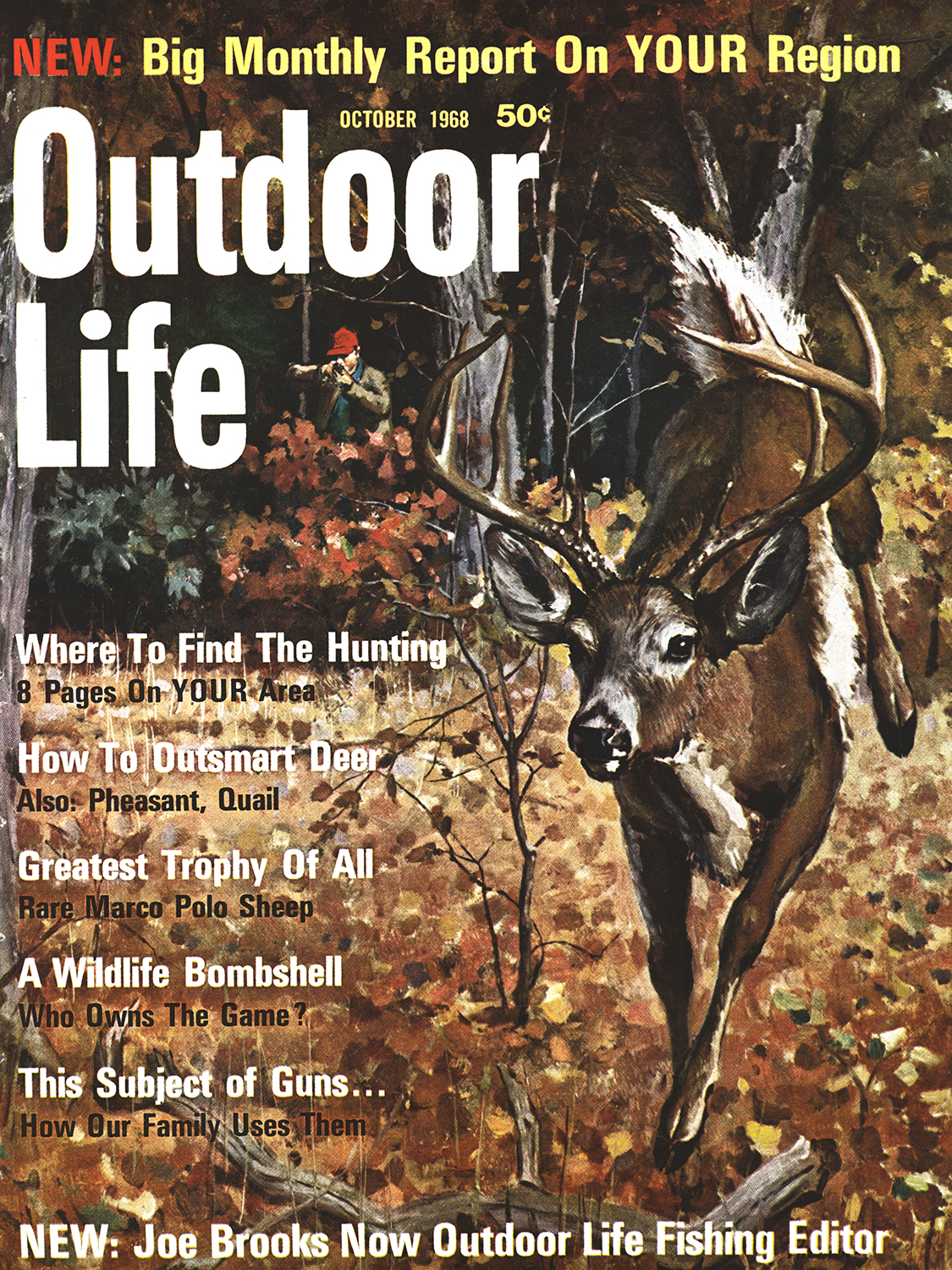
When the sound of the baying beagles started again, I was aghast. The dogs had split up and were running in opposite directions. While working out the loss, Star had jumped another hare. Things were really getting confused.
The dogs worked slowly and uncertainly. In the distance, sounding like popguns, the .22’s started talking. Both Bill and Dad were shooting. I couldn’t help but chuckle. Staid old Dad was shucking them out as fast as brother Bill.
Like a duet, a chorus of “I got ’im,” drifted through the dense swamp. I ran for Bill. As I approached, I saw him kneeling over Star. The hound was worrying a full-grown white hare in the soft snow.
“Congratulations,” I called out as I jogged by and headed for the spot where Dad and the other two hounds were kicking up an awful fuss. As I approached, a spruce dropped a load of snow down my neck.
“Look what I got, Son,” Dad chortled. “Isn’t he a beauty? Must weigh over four pounds, and not a white hair on him. What a chase he gave us!”
Read Next: A Christmas Bargain: Rabbit Hunting with My Boys Every Day of Winter Break
“You don’t know the half of it,” I replied, shaking the snow out of my collar. “That devil really made a monkey out of me. I’ll never forget this hunt as long as I live.”
THAT NIGHT as we sat around the supper table, Dad told the day’s events for the benefit of the wide-eyed grandchildren.
“Let’s see now,” he said as he gestured with his favorite steak knife, “the last melano was killed on Halcott Mountain just 34 years ago. If history keeps repeating itself, Grampy ought to be able to take you youngsters back up there in 1993, and we’ll get us another one of those black white rabbits—if you can stay on your feet, keep your gun loaded, and hit what you’re shooting at.” With that, he winked at Bill and me.
Melano or no melano, I couldn’t think of a nicer way to spend a Christmas than on a family hare hunt.
